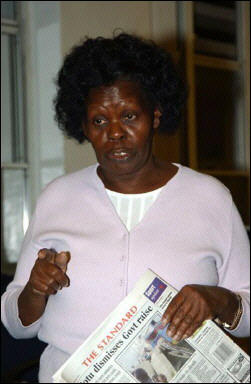 By Charles Onyango-Obbo
By Charles Onyango-ObboAt the height of the post-election violence, a photograph that has become the symbol of the Kenyan crisis was shot by a Reuters photographer in Naivasha.It was published by newspapers in Uganda, Tanzania and many newspapers in the world. It then did the rounds on the Internet so much so that I was getting a copy of it in my in-box every hour from all sorts of people. It showed a woman lying dead in a humble living room, with a screaming baby sitting next to her in a chair. Even if you have a heart of stone, you can’t help but be horrified by the photograph.
The photo was published nearly everywhere, except the mainstream press in Kenya. Editors argued that, among other things, it was likely to inflame passions and fuel the violence, and also further traumatise a nation that was already in shock at the genocidal brutality that had beset it.
It’s a month later, and one hardly hears any more reference to that photograph. But there are certain moments in a nation’s history that should never be brushed aside quickly, and there are victims of national tragedies who should never be forgotten.
That dead woman, and the child are among them. The real story of the photo is very poignant, and the circumstances of the woman’s death more complicated than most people first thought. “A woman lies dead during ethnic clashes in Kenya” was how Reuters captioned the photograph. In the Naivasha Hospital mortuary, her body was labelled number 33. It was among 36 victims of the violence whose corpses were still in white zip-up bags piled four high on the concrete floor. A reporter with The Observer says she first recognised her as the woman in the Reuters photograph from her skirt.
The woman in the photograph was 19-year-old Grace Mungai. She didn’t have much, but everyone, reported the paper, says she was happy and doted on her 15-month-old first-born baby, Brian Shfutu Mungai. For the past four months, she had lived in a rented room in Komokomo slum. Her husband, Jeremiah Mungai, adored her. A “true” African man, Jeremiah had another wife elsewhere in Naivasha, but he was a kind man, according to friends and neighbours. Grace, to use the politically correct but disembowelled language of the day, was from “a certain community in Western Kenya”. And Jeremiah is from “a certain community in Central Kenya”. Grace was killed on January 28, not by a gang thirsty for tribal retribution as many people who viewed the photograph might have thought, but by a police officer’s bullet that was fired into the house.
The officers were firing to scare away looting and murderous mobs, but Jeremiah thinks it was deliberate. The bullet struck Grace behind the ear. The offending officer offered some kind of apology, but Jeremiah is in no forgiving mood. As The Observer put it; “Jeremiah will just have to live with the injustice of Grace’s death, a young woman who never had a camera pointed at her when she was alive”. One of the most thoughtful reflections in the international press on the fate of Kenyans like Grace and others who have been “ethnic cleansed”, came via Andia Visa, writing in The Guardian about the Kenya of many years ago when, as a child, she and her family travelled from Mombasa once a year to western Kenya to visit her grandparents, and how much the violence has overturned most of the old certainties:
“The idea of Kenya belonging to all Kenyans and Kenyans having the right to live where they like is dead in the water. For some of the victims of the violence in the Rift Valley, this is the second or third time they have lost everything. Many have vowed never to come back. The message being telegraphed by the violence is that the only really safe place to put down any roots is among your own kind. Will any ‘outsiders’ ever again stake their livelihoods and buy land outside their districts of origin? Will we all retreat to the safety of our homogenous ethnic enclaves? Will we ever again be able to look each other in the eyes, to suppress the knowledge of the things we have done and are capable of doing to each other?”A colleague provided an answer of sorts about the Kenya of the future. Looking at the chaotic and charged scenes at the election of various mayors in the country, particularly Nairobi, he remarked: “It’s a tragedy. It seems we have become a country where we can’t even elect the chairman of a village cattle dip without controversy”.



Comments